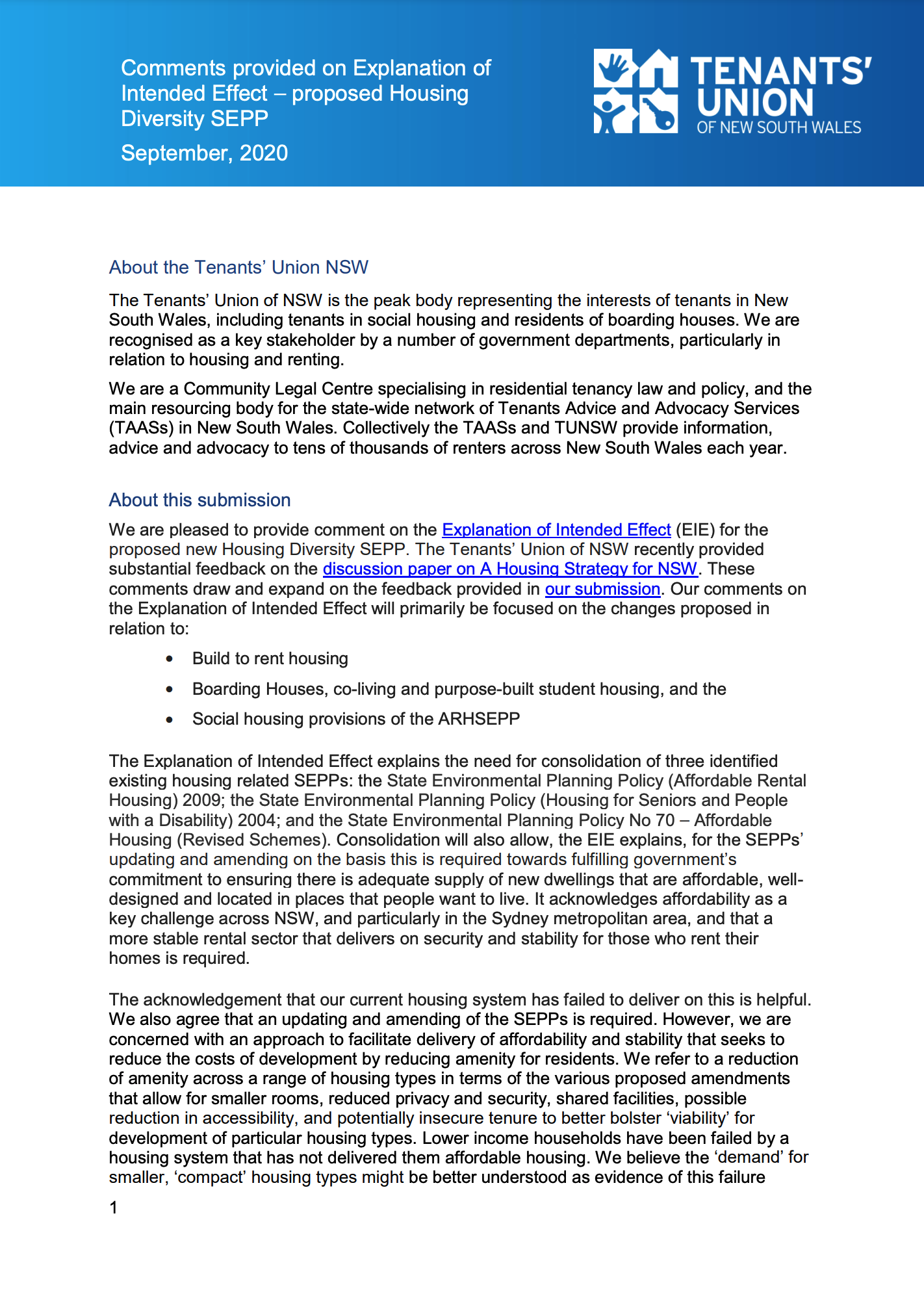Submission: Explanation of Intended Effect – proposed Housing Diversity SEPP
01/09/2020
We are pleased to provide comment on the Explanation of Intended Effect (EIE) for the proposed new Housing Diversity SEPP. The Tenants’ Union of NSW recently provided substantial feedback on the discussion paper on A Housing Strategy for NSW. These comments draw and expand on the feedback provided in our submission. Our comments on the Explanation of Intended Effect will primarily be focused on the changes proposed in relation to:
- Build to rent housing
- Boarding Houses, co-living and purpose-built student housing, and the
- Social housing provisions of the ARHSEPP
The Explanation of Intended Effect explains the need for consolidation of three identified existing housing related SEPPs: the State Environmental Planning Policy (Affordable Rental Housing) 2009; the State Environmental Planning Policy (Housing for Seniors and People with a Disability) 2004; and the State Environmental Planning Policy No 70 – Affordable Housing (Revised Schemes). Consolidation will also allow, the EIE explains, for the SEPPs’ updating and amending on the basis this is required towards fulfilling government’s commitment to ensuring there is adequate supply of new dwellings that are affordable, well designed and located in places that people want to live. It acknowledges affordability as a key challenge across NSW, and particularly in the Sydney metropolitan area, and that a more stable rental sector that delivers on security and stability for those who rent their homes is required.
The acknowledgement that our current housing system has failed to deliver on this is helpful. We also agree that an updating and amending of the SEPPs is required. However, we are concerned with an approach to facilitate delivery of affordability and stability that seeks to reduce the costs of development by reducing amenity for residents. We refer to a reduction of amenity across a range of housing types in terms of the various proposed amendments that allow for smaller rooms, reduced privacy and security, shared facilities, possible reduction in accessibility, and potentially insecure tenure to better bolster ‘viability’ for development of particular housing types. Lower income households have been failed by a housing system that has not delivered them affordable housing. We believe the ‘demand’ for smaller, ‘compact’ housing types might be better understood as evidence of this failure rather than as a desire on the part of people on lower incomes for compromised design and amenity, and lesser, more insecure renting arrangements (leasing agreements).
We are concerned that the range of proposed new SEPP provisions are not generally referenced within a broader strategy of reform to more effectively support the supply of new, additional social and affordable housing. Such a strategy, we have suggested elsewhere, should include reform of tax settings at both the state and Commonwealth level, and significant capital investment from both levels of government in public and community housing to improve existing stock, and build new, additional social housing.
We recognise it is not within scope or the role of planning instruments to address or ‘fix’ systemic issues such as a lack of affordable and secure rental housing. We highlight this only to make the point changes to planning provisions that may reduce amenity for residents of new housing, or fast-track and thereby reduce the opportunity for stakeholder and community consultation should not be pursued on the basis that they are a real solution to these problems.


